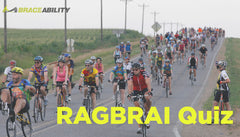Spondylitis
What Is Spondylitis?
Spondylitis (pronounced spon-dill-eye-tiss) is a form of arthritis that commonly occurs in your back. Ankylosing spondylitis basically refers to the inflammation of the joints in your spine. Let's back up for a minute and explain the parts of your spine. There are 3 components you should be aware of:
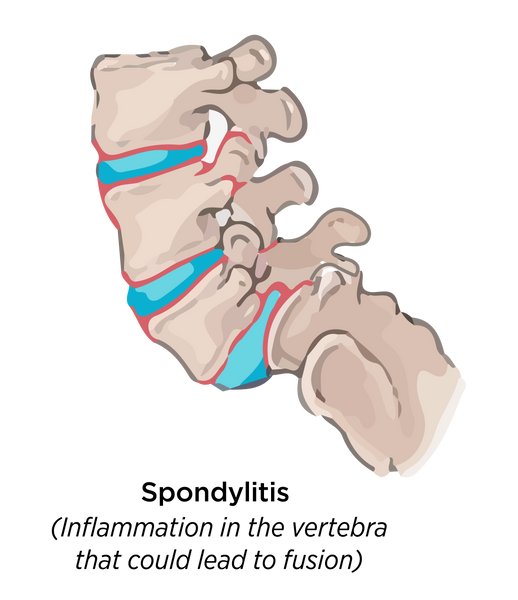
- Vertebra - the bones (think of them as the building blocks that create your spine)
- Facet joints - small joints that extend off of each vertebra. Each vertebra has 4 facet joints connected to it, one pair that faces upward and connects to the vertebrae on top of it (called the superior facet), and one pair that connects to the vertebrae below (the inferior facet). Healthy facet joints are covered with cartilage and fluids which allow them to remain lubricated so they can glide smoothly against each other.
-
Intervertebral discs - your discs act as a cushion between each vertebra (basically, the glue that holds the bones in your spine together.) They consist of an outer fibrous ring with a gel-filled center (kind of like a jelly donut).
So your facet joints work in conjunction with the discs between each vertebra to absorb shock and essentially function like a hinge - allowing your spine to bend and twist. When your joints become inflamed, it can eventually lead to your vertebrae fusing together and becoming stiff. This is where you get the term 'ankylosis'. Although it’s more common to be found in your spine, spondylitis can also affect other joints in your body such as your ribs, hips, shoulders, and knees.
What Causes Spondylitis? Am I More Prone To Developing Ankylosing Spondylitis?
The direct cause of spondylitis has yet to be found, but medical professionals believe it to be an autoimmune disease, caused by your body's own immune system attacking healthy tissue and causing damage to your joints, which results in inflammation. Around 90% of individuals diagnosed with spondylitis have a gene called HLA-B27. This is why spondylitis is thought to be a genetically inherited disease, passed down through generations. To check whether you have this specific gene, your doctor can take a blood test to detect it.
Other causes of ankylosing spondylitis include:
- Gender: Men are more likely to develop this condition.
- Age: The most common ages for developing this condition is between 20-40.
Ankylosing Spondylitis Symptoms
Symptoms of spondylitis can vary from person to person. Symptoms typically occur between the ages of 18-45 years, although it is possible to experience symptoms aside from those ages. Symptoms of this condition can come and go for an irregular period of time. The most common symptom of ankylosing spondylitis is stiffness or pain in the lower or lumbar region of your back and buttocks. This discomfort usually occurs in the morning or at night. In addition, you may have a low-grade fever and loss of appetite.
Other symptoms may include:
- Fatigue and anemia
- Issues with your bowel movements
- Inflammation in your eyes (watery, red, irritated, and blurred vision)
- If your condition has progressed, you may even have a lack of mobility in your spine
Diet for Ankylosing Spondylitis Individuals
It has been common for those who suffer from arthritis to modify their diet as some foods may trigger symptoms. Those who have ankylosing spondylitis may find it beneficial to figure out certain foods that might increase or decrease your pain to help you with your condition. Keep in mind, this modification will not cure your condition completely but could help ease your symptoms and discomfort. Below are some suggestions to try if you’re looking to change up your diet for ankylosing spondylitis!
Foods to eat:
- Omega-3: salmon, flax seeds, walnuts, kale, spinach, and greens
- Fruits and vegetables
- Whole grains (this has been proven to go, either way, so you might have to try it out first)
- Foods high in vitamin D
- Dietary supplements might help you get the extra nutrients you’re missing
Foods to avoid:
- Added sugar
- Foods high in sodium
- Preservatives
- Alcohol
- Foods high in starch: bread, pasta, and rice

In addition to changing your diet, if you’re a larger or plus size individual, you might experience more inflammation in your joints. The extra weight that you are carrying around forces your back and spine to work harder to keep your body upright. If you suffer from spondylitis, losing weight can also help alleviate your symptoms. Unsure if you’re considered obese? Check out this quick BMI calculator to see.
On another note, those with spondylitis may experience a loss of appetite as a result of fatigue and loss of energy. Some medications also may lead to weight loss. If you’re losing an extreme amount of weight, it’s important to report it to your doctor.
What’s the Difference Between Spondylitis, Spondylolysis, & Spondylolisthesis?
Differentiating between spondylitis, spondylolysis, and spondylolisthesis is actually quite simple. Although you may think they are all very similar, the term 'spondy' just means spine, which comes as no surprise as all three of this conditions involve the spine.
What’s spondylitis? Hopefully, by now you are familiar with what ankylosing spondylitis but to refresh your memory, spondylitis is inflammation in your spine and is a form of arthritis.
What’s spondylolysis? Spondylolysis is a defect of the bones in your spine known as the pars interarticularis, which is the small bony arch towards the back of your spine.
What’s spondylolisthesis? Spondylolisthesis is when one of your bones in your vertebrae slides forward or backward over the bone next to it.

Ankylosing Spondylitis Conservative Home Treatment Guidelines
Unfortunately, there is no cure for spondylitis but there are numerous treatments you can try to help reduce inflammation and make living with this condition comfortable. For starters, it’s advised to try conservative methods first to see if that helps to ease your pain and most cost-efficient.
Anti-inflammatory medications: Can be an ankylosing spondylitis treatment option to help reduce your pain and stiffness. Other medications that have been found to help with this condition are known as TNF Blockers that help treat joint arthritis.
Correcting your posture: Is also an easy and quick way to help stop further progress or curve in your spine. Try wearing a posture brace to help train your muscles to stand upright in the correct position. This posture stance will prevent you from developing kyphosis, which can be a consequence of spondylitis. Wondering what your current posture level is? Take this quiz to find out!
Hot and cold therapy: Can be a very beneficial way to help give you relief from inflammation. You can try a warm bath to help loosen up your muscles before you stretch. Applying cold can help reduce swelling while applying heat can increase blood flow and decreases muscle spasms. Try our heat and ice lower back wrap to easily apply both cold and hot therapy!
Sleeping on a firm mattress: Can also help to keep your back straight and prevent any extra curvature in your spine. Try avoiding propping your legs up with pillows or placing a large pillow behind your neck as this may lead to hip or neck fusion in your spine. In addition to a firm mattress, it’s advised for those who suffer from spondylitis to sleep on their belly to promote good posture while sleeping.
Quitting smoking: Avoiding or quitting smoking can affect the mobility of your rib cage, ultimately leading to breathing problems.
Keep moving around: As mentioned above, spondylitis pain increases in the morning and at night typically after periods of rest. Therefore, it’s important to keep moving around! It can be as simple as taking a walk twice a day to help prevent your joints from stiffening up. Physical therapy is also used to help improve your flexibility and strength.
Ankylosing spondylitis exercises: Help promote flexibility and correct posture to help manage your pain. Here are five exercises you can try at home:
-
Press up: Lie on your stomach with your legs behind you. Slowly, bring yourself up on your elbows with your chest off the ground. Hold for 10 to 20 seconds then repeat.

-
Wall sit: Stand with your back against the wall with your feet shoulder-width apart. Slowly slide your back down the wall like you’re sitting in a chair. Hold for 10 seconds then repeat.
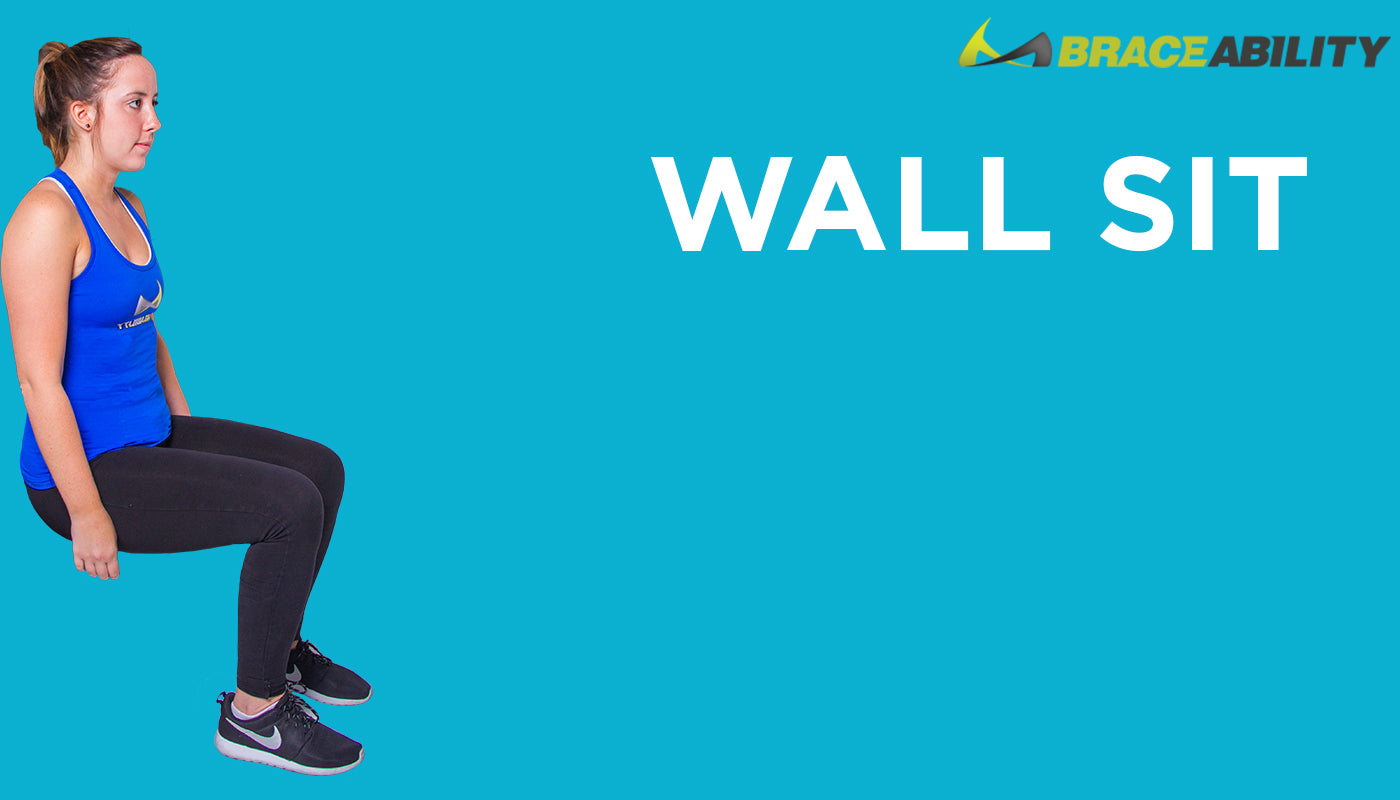
-
Plank: Start by kneeling on the ground and put your forearms resting on the ground in front of you. Push your legs out behind you and balance yourself on your toes. Squeeze your stomach and butt muscles to hold your body in a straight line. Hold for 5-10 seconds. You can add more time once you strengthen your core.
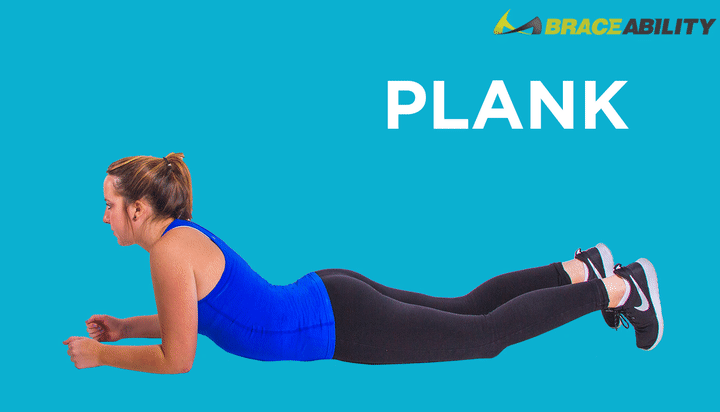
-
Leg raises: Use the back of a chair for support, keep your back straight with a slight bend in your knees. Slowly lift one leg out to the side off the ground. Lower it back down then do the same for the opposite leg.

-
Hip stretch: Place your hands on your hips for balance then take a step forward. Sink into a lunge position but place your back knee down on the ground. Hold for 20-30 seconds then repeat with the opposite leg.
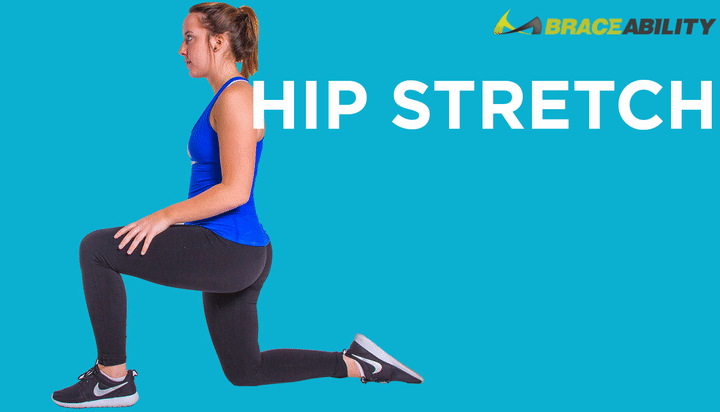
Yoga: In addition to the exercises above, yoga is a great way to help relieve your pain. Make sure you ease into your yoga poses, as hyperextending your back or pulling muscles will cause more harm than good.
Surgery for Ankylosing Spondylitis
For severe cases of spondylitis arthritis, surgery is advised to help replace the damaged and inflamed joints. Surgery is typically done for hip and knee spondylitis and is rarely done for lumbar spondylitis. If you suffer from a postural issue from spondylitis, your doctor might correct your curvature deformity in your spine but this is considered a risky process. In addition, if you suffer a neurologic deficit such as nerve weakness or numbness, surgery may be considered.








